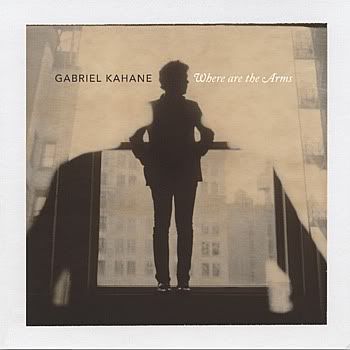
[purchase]
When I reviewed Gabriel Kahane’s self-titled album two years ago, I found an artist who came from the world of contemporary classical music, and reached into the world of pop music, but on his own terms. The result was an album of sometimes challenging, but always fascinating music. Where Are the Arms is Kahane’s follow-up to that album, and this time Kahane is continuing the journey with some interesting friends. Rob Moose has worked with Bon Iver, Anthony and the Johnsons, and The National. Casey Foubert, who co-produced this album, has worked with Sufjan Stevens, Richard Swift, and Pedro the Lion. And Matt Johnson’s credits include Jeff Buckley and Rufus Wainwright. The featured instrument is usually the piano, but some songs feature acoustic or electric guitar instead. Sometimes there are actual drums, while other songs may have soft percussion, or no percussion at all. The texture of the music shifts constantly, with accents provided by string, brass, and/or woodwind sections. I use the names for these sections that are used in classical music, because that is how Kahane uses them; instead of the wall of sound found in pop music, here each of the wind players, for example, has their own part to play, and it adds up to a wonderfully detailed whole, even though these sections are small.
Where Are the Arms takes off musically from where the last album ended. Lead track Charming Disease starts off sounding like it could have been on the previous album, but then the song changes. Rock elements join in, and the song becomes more assertive as it goes along. Parts of Speech lays down a shimmering pattern of electric guitars, then adds a kick from the drums, and finally finds Kahane singing in a voice with more bite than I have heard from him before. Kahane shows on this album that he can be a fine rock singer when needed. Last Dance is a lament, but there is a break where Kahane must sing some blue-eyed soul. He pulls it off, and the moment becomes one of this album’s delightful surprises. Calabash & Catamaran starts off sounding like it will be a folk number, (there is even a banjo), but layers of sound are added until it becomes a driven art-rock piece. The album closes with Great Lakes, and things seem to have settled down, but the song has a big rock climax at the end. Overall, Where Are the Arms takes the contemporary art song approach of the last album, and successfully weds it to some indie rock sensibilities.
Where Are the Arms is a collection of songs about missed and missing connections. Merritt Pkwy tells the tale of a hitchhiker who is picked up by a woman. They wind up spending a romantic-seeming day together, and the listener would expect this to turn into a happy ending if Kahane hadn’t warned us otherwise. I don’t want to spoil it for you, but suffice it to say that Kahane displays a wicked sense of humor, and his narrator has a sour memory to take from his adventure. Barn Song explores how language, or the lack of it, can separate young from old. Last Dance looks at how a death always seems to strike before we get to do that one last thing with the person we lose. And LA explores how an environment can lead to alienation. These are weighty topics, and Kahane does a great job of conveying all of these different moods with amazing vocal versatility. But what is even more remarkable is that the album is not a downer at all. Instead, Where Are the Arms is collection of portraits that draw our sympathies. The lyrics are spare, but they are free of cliché, and the performances of Kahane and his guests fill in any blanks. I am tempted to say that Kahane has arrived at his musical destination, but I suspect that that will only be true until the next album. I look forward to hearing it.
Gabriel Kahane: Charming Disease
Gabriel Kahane: Calabash & Catamaran






